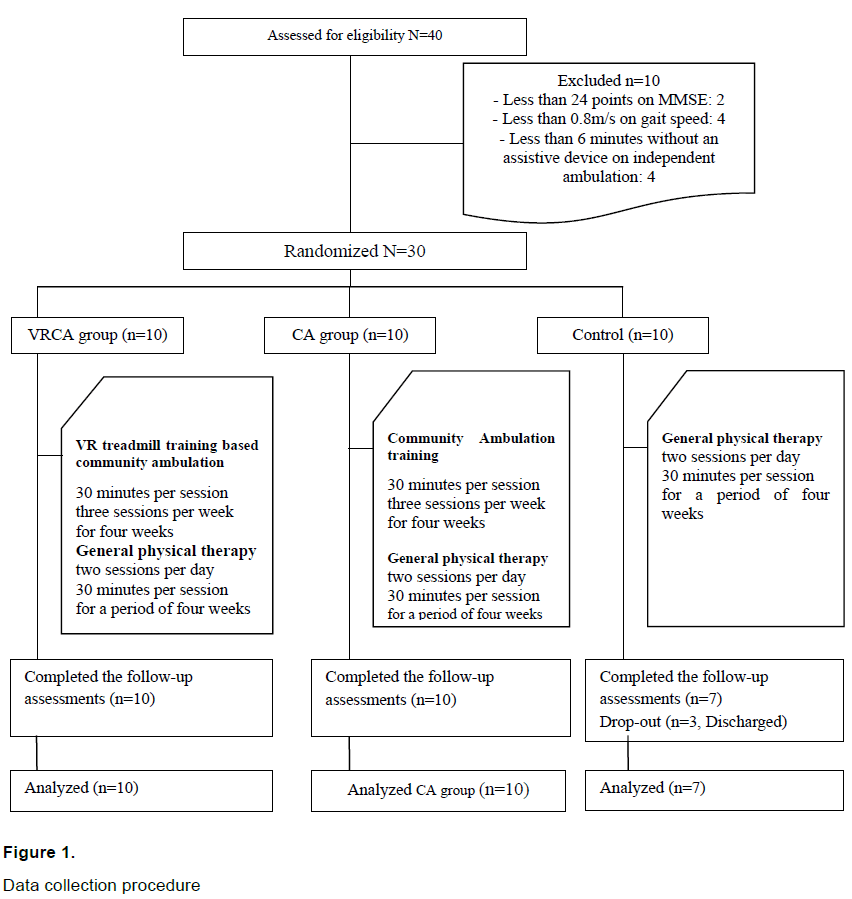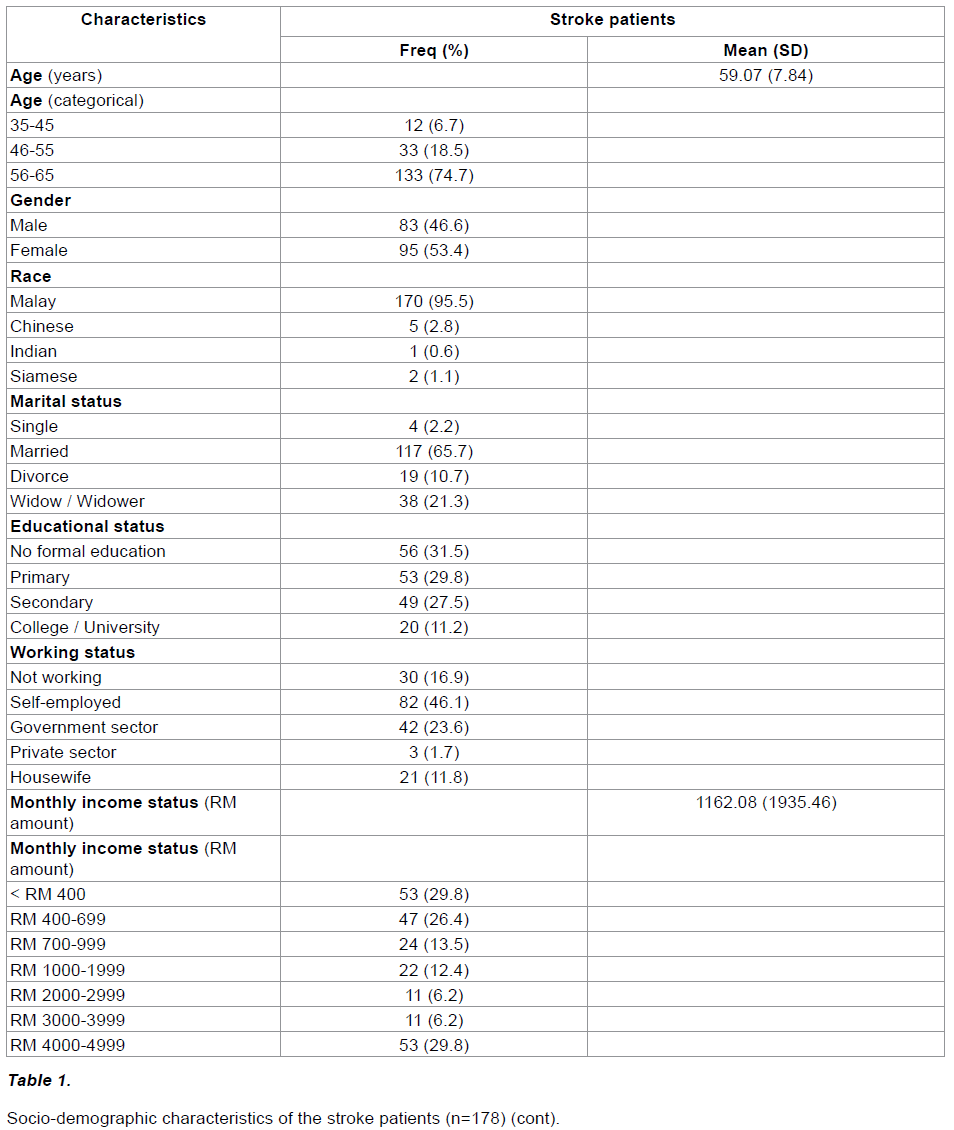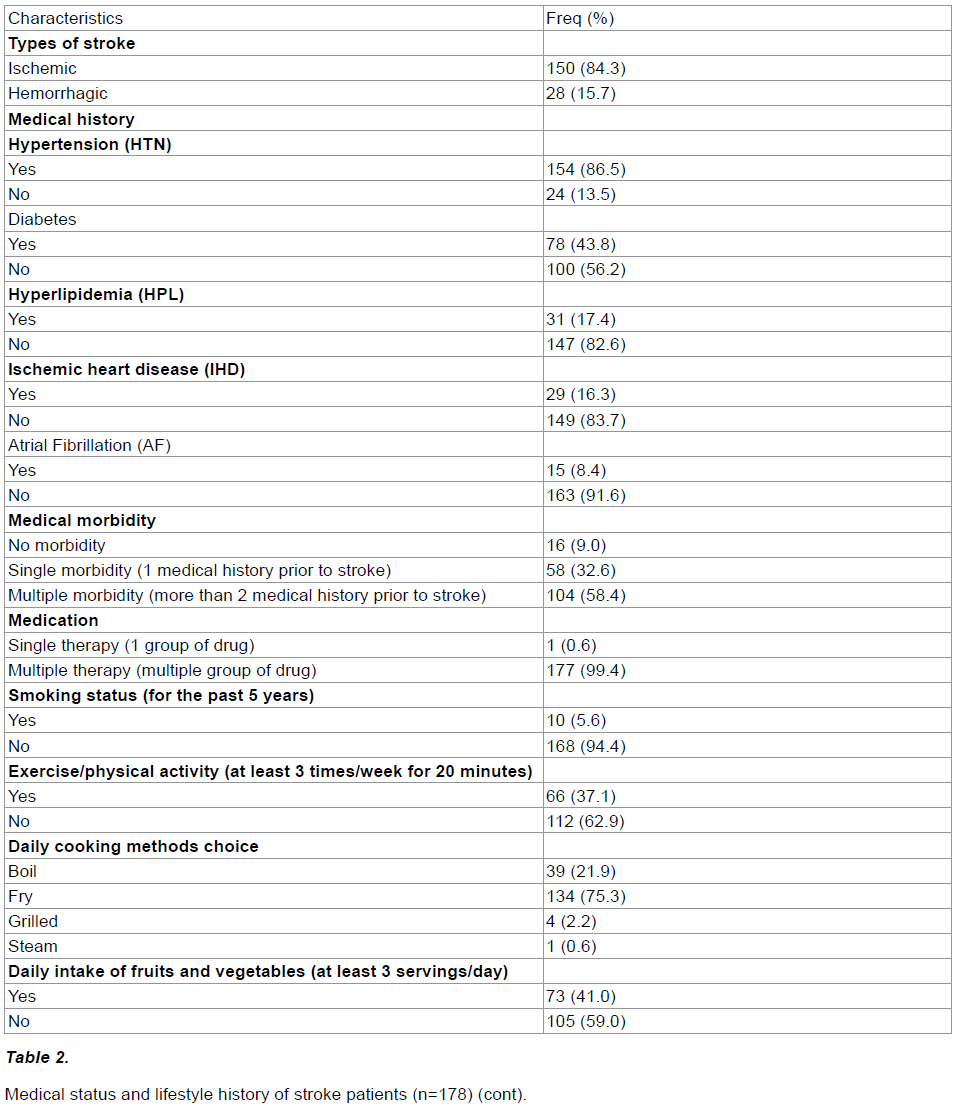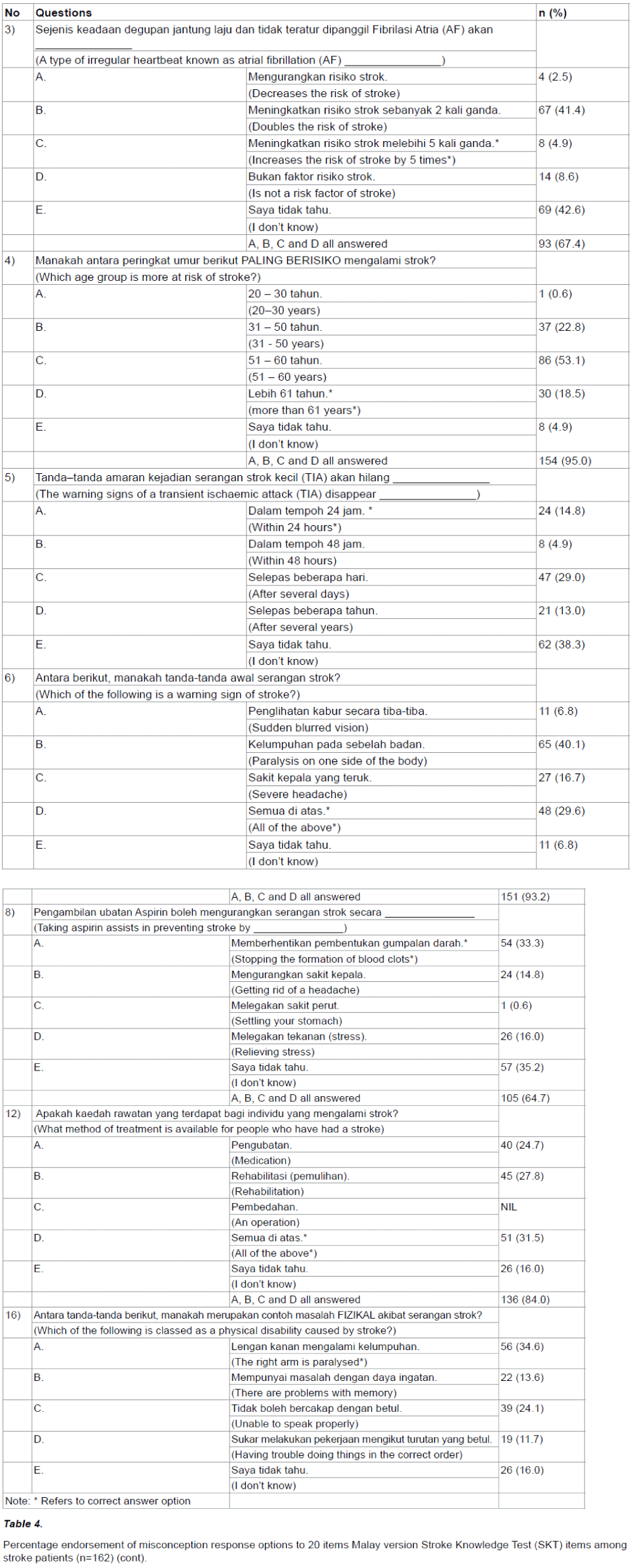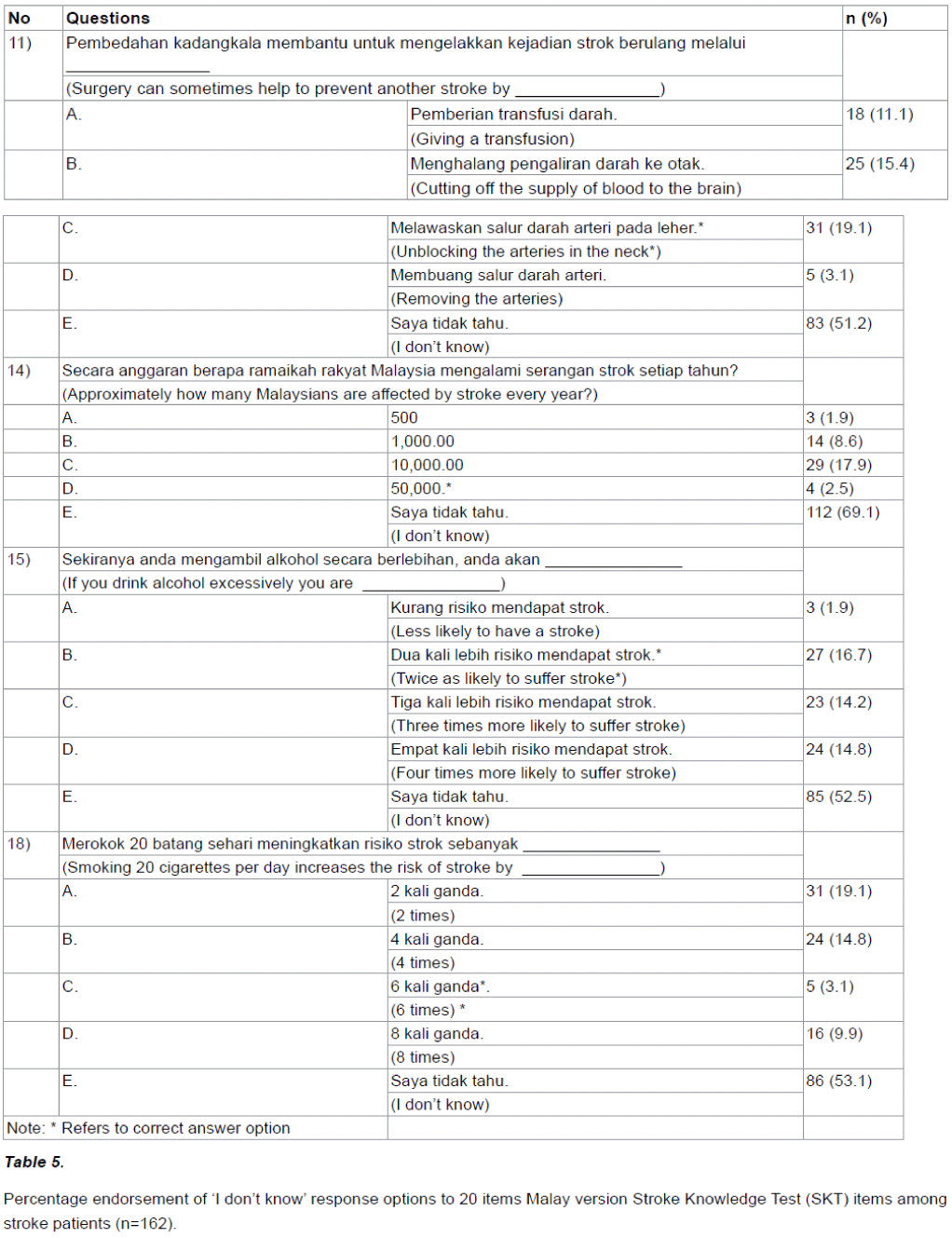Research Article - Journal of Experimental Stroke & Translational Medicine (2016) Volume 9, Issue 1
Stroke Knowledge Level Among Stroke Patients Admitted to Hospital Raja Perempuan Zainab II, Kelantan, Malaysia
- *Corresponding Author:
- Siti Noorkhairina Sowtali
Kulliyyah of Nursing, International Islamic University Malaysia
Level 2, Jalan Hospital Campus, Malaysia
Tel: 60127264236
E-mail: sitisowtali@gmail.com
Published Date: March 21, 2016
Citation: Sowtali, Harith, Mohamed, Mohd Yusoff. Stroke Knowledge Level among Stroke Patients Admitted to Hospital Raja Perempuan Zainab II, Kelantan, Malaysia. J Exp Stroke Transl Med. 2016 March. Online access at www.jestm.com
Abstract
Level of stroke knowledge among stroke patients determine their immediate response during stroke attack. Thus, this study was to determine the level of stroke knowledge among stroke patients at Hospital Raja Perempuan Zainab II, Kelantan, Malaysia. A crosssectional survey was carried out among stroke patients admitted to medical and surgical wards of Hospital Raja Perempuan Zainab II. Stroke patients were selected conveniently and the data was collected within eight months period. The Malay version Stroke Knowledge Test scale with 20 items was used to evaluate knowledge on stroke disease. Overall, there were 178 stroke patients involved in this study. The participants’ mean age were 59.07 years old with majority falls between 56 to 65 years old (74.7%). Most of them were female (53.4%), Malays (95.5%) and they had multiple medical morbidities. In terms of stroke knowledge level, 45% answered correctly on 9 items, 35% had misconception on 7 items (35%), while 20% wrongly answered on 4 items. This study highlighted that stroke patients had lack of knowledge towards stroke disease. Therefore, conducting stroke education session in routine prior to hospital discharge is important.
Keywords
Stroke knowledge test; knowledge level; stroke patients; clinical status; stroke education
Introduction
Accurate identification of stroke signs and symptoms and risk factors might have impact on individuals’, family members and bystander’s immediate action in assessing healthcare during the stroke attack. Indirectly, this will influence the time-sensitive benefits of reperfusion therapy. However, lack of knowledge on the stroke disease might impact on one’s understanding on the treatment and rehabilitation process after stroke.
Stroke is characterized as an acute neurological deficits and mostly related with vascular origin (WHO, 2012). In Malaysia, stroke is the top five common causes of mortality with the rate at 8.43 per 100000 populations after cancer and pneumonia (WHO 2012, Tharakan 2012). There are two types of stroke which are ischemic stroke and hemorrhagic stroke (Tharakan 2012). Both types of stroke will results in disabilities that actually can be reversible if appropriate and early emergency action is taken.
The windows phase for administration of intravenous (IV) recombinant tissue plasminogent activator (rTPA) or anti-thrombolytic agent such as Aspirin or Clopidogrel are between 3 to 4 hours after initial sign and symptoms to preserve the penumbra area of the brain (Engelter ST et al. 2006, Lees KR et al. 2008, Kollmar R 2007). This immediate response requires one to recognize the signs and symptoms to gain benefit from the treatment. Furthermore, rehabilitation process should also begin intensively as early as 48 hours after hospitalization and continuously even until one year after stroke attack (Murphy TH and Corbett D, 2009).
However, most of studies that measures level of stroke knowledge had been carried out in the developed nations among various population, including stroke patients (Nguyen TT et al. 2009, Reeves MJ et al. 2008, Pandian JD et al. 2006). To date, such study is almost none in Malaysia as well as among ASEAN countries, particularly among stroke patients (Mohamed CR 2010; Nazifah S, 2012). Therefore, we aimed to assess the level of knowledge among stroke patients pertaining to stroke disease in this study.
Materials and Methods
Study design, population and setting
A cross-sectional study was conducted among 178 stroke patients who admitted to Medical and Surgical wards in Hospital Raja Perempuan Zainab II (HRPZ II), Kelantan, Malaysia. The HRPZ II had begins it operation since 1920 as an educational, service and clinical research hospital. It was located in Kota Bharu, the main city of Kelantan. Until 2011, HRPZ II was occupied with 920 beds. Stroke patients are usually admitted into the Medical Ward, Surgical Ward and Intensive Care Unit.
The sample size was calculated using single proportion formula and also by considering the 10% of possible drop out. Statistically, it was estimated that 52,000 people suffered strokes annually, with mortality rates in the public hospitals ranging from 8.19% - 9.27% per year since 2000 (Azlin N 2009). Thus, the proportion of stroke patient towards Kelantan population ranged between 35 to 65 years old was 52,000 ÷ 448, 381= 0.116 = 0.12.
The inclusion criteria for this study includes: 1) first ever stroke diagnosed via Magnetic Resonance Imaging (MRI) or Computed Tomography Scan (CT Scan), 2) Mini Mental State Examination score (MMSE) more than 21, 3) Functional independence measure (FIM) at least 70, 4) age between 35 to 65 years old during recruitment and 5) living in Kelantan. While, the exclusion criteria were: 1) bilateral stroke, 2) having other neurological disease, 3) altered consciousness, 4) global aphasia and 5) having depression. This study began in January 2013 and ended in August 2013. Ethical clearance was obtained from the National Medical Research Register [Ref. no. KKMNIHSEC/08/0804/P12-882] prior to study.
Research instrument
A set of questionnaire was used in this study to obtain data on socio-demographic, clinical status, lifestyle history and stroke knowledge level using the Malay version Stroke Knowledge Test (SKT). The SKT was adapted from an Australian study and its validity and reliability of the Malay version was further explained in other publications (Sullivan K and Dunton NJ 2004, Sullivan KA and Waugh D 2005). This questionnaire was distributed to the stroke patients during hospitalization period once their condition stable after the stroke attack.
Data collection procedure
Stroke patients who fulfilled the inclusion criteria were given an explanation regarding the study and informed consent obtained. Stroke patients were required to complete the questionnaire between 30 minutes to one hour. The researcher was presented along the session to assist whenever necessary (Figure 1).
Data analysis
Data obtained from the study were entered into the Statistical Package for Social Sciences (SPSS) version 20.0 software. Descriptive statistics were employed to summarize the results. Data were interpreted as mean and standard deviation for numerical outcome. Meanwhile, frequency and percentage were used for categorical outcome.
Results
Socio-demographic characteristic
The socio-demographic characteristics of stroke patients in this study are shown in (Table 1). Initially, 229 stroke patients met the inclusion criteria. However, only 178 were recruited based on sample size calculation. The mean age of the stroke patients were 59.07 years old with majority falls between 56 to 65 years old (74.7%). Most of them were female (53.4%), Malays (95.5%) and married (65.7%). Moreover, majority of the stroke patients had no formal education (31.5%) and self-employed (46.1%) with mean monthly income salary of RM 1,162.08 (USD 280.02).
Table 1: Socio-demographic characteristics of the stroke patients (n=178) (cont).
Medical and lifestyle history of stroke patients
Data on the medical and lifestyle history of the stroke patients are shown in (Table 2). Majority of the stroke patients were diagnosed as ischemic stroke (84.3%). They had history of hypertension (86.5%), diabetes (43.8%), hyperlipidemia (17.4%), ischemic heart disease (16.3%) and atrial fibrillation (8.4%) and received multiple pharmacology therapy (99.4%) to treat their medical illnesses after stroke attack. With regards to lifestyle history, only 11 (26.9%) stroke patients were smokers for the past five years prior to stroke. Meanwhile, few of them perform routine exercise (37.1%) and majority preferred fried food (68.3%).
Stroke knowledge level
Results on the stroke knowledge level was analysed for all 162 stroke patients who had completed the questionnaire. The result indicates three different groups of patients. This include those with correct, had misconception and totally wrong answers about stroke as shown in (Table 3) to 5. Overall, the mean score of the stroke knowledge level was 7.87±2.79 among the stroke patients in this study. The cut off point for good knowledge level were 50% of the 20 items.
Correct answer response regarding stroke disease
The correct responses to SKT items reflected relatively good understanding of stroke disease. This was defined as 50% or more of the stroke patients endorsed the correct response option (Sullivan K and Dunton NJ 2004, Sullivan KA and Waugh D 2005, Sowtali SN 2015). Overall, there were 9 out of 20 such items (N=45%) with 50% or more endorsement of the correct option as reported in (Table 3). The items with correct response were item number 1, 2, 7, 9, 10, 13, 17, 19 and 20. The percentage of the items correctly identified by the stroke patients were ranged from 49.4% to 84.6%. These items were pertaining to pathophysiology of stroke formation, stroke risk factors, stroke prevention, immediate response to stroke occurrence and purpose of rehabilitation.
Common misconceptions regarding stroke disease
Commonly held misconceptions were indicated when 25% or more of stroke patients endorsed an incorrect response option (Sullivan K and Dunton NJ 2004, Sullivan KA and Waugh D 2005, Sowtali SN 2015). This shows that the stroke patients might have wrong concept regarding stroke disease or had made a choice by guessing. There were 7 out of 20 such items (N=35%) were endorsed with multiple answer options as reported in (Table 4). These items included item number 3, 4, 5, 6, 8, 12 and 16 which related to stroke risk factors, stroke sign and symptoms and stroke disabilities. The percentage of the items commonly having misconceptions among the stroke patients were ranged from 31.5% to 53.1%.
Common ‘I don’t know’ response regarding stroke disease
Stoke knowledge is defined as ‘I don’t know’ if 50% or more of the stroke patients endorsed this option (Sullivan K and Dunton NJ 2004,Sullivan KA and Waugh D 2005, Sowtali SN. 2015). This ‘I don’t know’ option highlighted that stroke patients had no idea on the best answer. There were 4 out of 20 such items (N=20%) were endorsed with ‘I don’t know’ for items number 11, 14, 15 and 16 as reported in (Table 5). These four items were associated with stroke treatment, epidemiological findings and risk factors for stroke. The wrongly answered items were ranged from 51.2% to 69.1%.
Discussion
The objective of this study was to determine the level of stroke knowledge among stroke patients admitted to the HRPZ II. This study was carried out to identify those areas on stroke knowledge that were important. However, most of stroke patients were found to have poor knowledge as overall. Almost less than half of the stroke patients able to identified correct options for stroke related knowledge out of 20 SKT items administered. In this study, most of the stroke patients able to recognize the development of stroke which causes by blockage of the blood vessels. This revealed that the stroke patients had some awareness on the disease process. The understanding of disease process will help them to appreciate the difference between stroke and heart attack that is commonly confused by most people (Nguyen TT et al. 2009,Sullivan KA and Waugh D. 2005, Sowtali SN. 2015, Jones SP. 2010).
With regards to risk factors, hypertension (HTN) and diabetes mellitus (DM) were commonly known by half of the stroke patients to double the risk of stroke attack. This finding was in line with a study conducted in America and Poland which reported that HTN, dietary pattern, smoking, overweight, physical inactivity and high cholesterol were mostly reported among adults (Reeves MJ. 2008, Das S and Das SK . 2013, Zeng Y at al. 2012). However, nearly half of the stroke patients in this study did not know that arterial fibrillation (AF) induced the occurrence of stroke more severe among other risk factors. Similar pattern were found in other studies that highlighted other important risk factors including AF, chronic pressure and metabolic syndrome were also identified by less than half of the population with the range between 8.4% to 30% (Pandian JD et al. 2006, Sullivan KA and Waugh D. 2005, Wiszniewska M. 2012).
Knowledge regarding rehabilitation was good among majority of the stroke patients in this study. Half of the stroke patients had been able to recognize the purpose of rehabilitation as a mechanism to restore the function to the optimum level as possible. Furthermore, they can also identify an individual with stroke that required rehabilitation such as those with difficulty of movement, in speech and using language as well as having imbalance problems. This finding is similar to an Australian study (Pandian JD et al. 2006).
In terms of stroke treatment, the knowledge regarding medication and surgery as a mechanism to treat stroke was still lacking among the stroke patients in this study. Less than half of the treatments of stroke such as Aspirin as an anti-platelet and surgery to release the blockage were known by the stroke patients. These findings were similar to other previous studies that some of stroke patients did not know the purpose of anti-platelet and rTPA as a thrombolysis agent for stroke treatment (Wiszniewska M 2012, Zeng Y et al. 2012). This findings however, contradicted to studies conducted in Rotterdam and Australia when they found 81% and 79% of their stroke patients were able to understand the function of the anti-platelet agents in influencing the blood clotting process (Pandian JD et al. 2006, Maasland L et al. 2007).
The most common signs and symptoms recognized by the stroke patients in this study was paralyzed on the one side of the body. Similarly, this sign and symptom was also indicated in almost 90%, 62% and 61% of the stroke population in other studies conducted in Japan, India and The Netherland (Pandian JD et al. 2006, Maasland L et al. 2007). The trend was also similar in a study conducted in the America, whereby there was an increase in knowledge from 45.7% to 65.5% in recognizing weakness or numbness as warning signs of stroke (Reeves et al. 2009). This result highlighted misconceptions regarding the signs and symptoms of stroke whereby most stroke patients recognized paralysis of the body as the common one. In fact, there were few other signs and symptoms of stroke such as blurred vision or dizziness, such as nausea and vomiting as well as difficulty to understand speech.
In relation to emergency action, stroke patients in this study had chosen to call the ambulance if they suspect one’s had a stroke attack. This finding was in line with a study carried out in Poland which found that 96.5% of the patients with neurological problems other than stroke will also call an ambulance if they assumed a patient having a first stroke symptoms (Das S and Das SK. 2013). Recognition of these stroke warning signs and symptoms had been suggested to influence one’s ability to take immediate action and to seek for medical treatment.
Nevertheless, the results also indicate that the stroke patients in this study had lack of understanding on other few areas related to stroke. These include the impact of alcohol intake and smoking towards the occurrence of stroke. This might be influenced by the fact that majority of the stroke patients in this study were female and they rarely drink or smoked. Gender difference was found to have an impact on the level of stroke knowledge in a study conducted in Germany (Marx J et al. 2010). The study conducted by Marx et al. (2010) found that female had better knowledge and less medical morbidities compared to the male. Furthermore, the homogenous population in the current survey consists of stroke patients of Malay race and they are Muslim which forbidden the intake of alcohol and smoking.
Other than that, the stroke patient in this study also had poor knowledge on stroke epidemiology. This is evidenced by their inability to determine current occurrence of stroke attack in Malaysia setting. This highlighted the needs of more health education campaign among the public. Various medium can be utilized for knowledge distribution, for example by using various types of mass media such as printed materials (e.g. newspaper or pamphlet), electronics (e.g. television or radio advertisement) or internet to disseminate stroke information to the publics (Hodgson C. 2008, Khalib A and Natrah M. 2011, Siti Noorkhairina S. 2013, Patel N and Stone MA. 2015, Hoffman T and McKenna K. 2006). This is especially important as Malaysia are moving towards aging population, thus increase the risk of stroke attack (Lit PK 2007). Furthermore, the function of surgery as a treatment of stroke was poorly recognized as one of the stroke treatment especially. This might be probably due to most of the stroke patients in this study were having ischemic stroke. Thus, the common treatment being recognized were mainly thrombolytic agent or rehabilitation. Moreover, surgery will be opted only when there is severe blockage of the blood vessel more than 50% to 99% (Siti Noorkhairina S. 2013).
The findings had been able to prove that the level of stroke knowledge among the stroke patients was generally poor despite having medical morbidities. Nevertheless, this cross-sectional study had adopted a convenience sampling method which would have causes a selection bias. Therefore, the inferential of the results towards the whole stroke patients in Kelantan must be interpreted cautiously.
Conclusion
Findings from this study represents that the level of knowledge among the stroke patients were poor. Therefore, knowledge impart on this disease is required by the healthcare professionals in order to equip the stroke patients with a broad concept of stroke disease. These divergent findings may also due to the facts that not all hospitals in the region equipped with a stroke unit. Hospital with an established stroke unit will usually practice good dissemination of information pertaining to stroke since they have multidisciplinary experts in stroke area.
Acknowledgement
Financial assistance for this study was provided by:
1. Universiti Sains Malaysia via Short Term Grant (304/PPSKB61313012)
2. International Islamic University Malaysia (Academic Trainee Scheme)
3. Ministry of Education (SLAB Scholarship)
All of the authors listed had contributed in the study by involving in:
1. Siti Noorkhairina Sowtali: Data collection and manuscript writing
2. Sakinah Harith: Manuscript writing
3. Monniaty Mohamed: Data collection and manuscript writing
4. Dariah Mohd Yusoff: Manuscript writing
References
- Aziz N, Raymond A (2008) Managing further rehabilitation in longer-term stroke liatients in the community: A new aliliroach. Med Health 3: 1-6.
- Azlin N, Rizal A (2009) Health related quality of life (HRQOL) among stroke survivors attending rehabilitation centres in Selangor. Jurnal Kesihatan Masyarakat 15: 83-90.
- Das S, Das SK (2013) Knowledge, attitude and liractice of stroke in India versus other develolied and develoliing countries. Ann Indian Acad Neurol 16: 488-493.
- Engelter ST, Bonati LH, Lyrer liA (2006) Intravenous thrombolysis in stroke liatients of >=80 versus <80 years of age: A systematic review across cohort studies. Age and Ageing 35: 572-580.
- Jones Sli, Jenkinson AJ, Leathley MJ, Caroline WC (2010) Stroke knowledge and awareness: an integrative review of the evidence. Age Ageing 39: 11-22.
- Kollmar R, Schwab S (2007) Ischaemic stroke: acute management, intensive care, and future liersliectives. Br. J. Anaesth 99: 95-101.
- Lees KR, Ford GA, Muir KW, Ahmed N, Dyker AG, et al. (2008) Thrombolytic theraliy for acute stroke in the United Kingdom: exlierience from the safe imlilementation of thrombolysis in stroke (SITS) register. QJM 101: 863-869.
- Maasland, E, Koudstaal liJ, Habbema JDF, Dililiel DWJ (2007) Knowledge and understanding of disease lirocess, risk factors and treatment modalities in liatients with a recent TIA or minor ischemic stroke. Cerebrovasc Dis 23: 435-440.
- Mohamed CR (2010) The educational needs of home-based stroke liatients and family caregivers in Malaysia. (Dissertation). Doctoral Thesis, Victoria University of Wellington, New Zealand.
- Murlihy TH, Corbett D (2009) lilasticity during stroke recovery: from synalise to behaviour. Nat Rev Neurosci 10: 861-872.
- Nazifah S, Azmi I, Hamidon B, Looi I, Zariah AA., et al. (2012) National Stroke Registry (NSR): Terengganu and Seberang Jaya exlierience. Med J Malaysia 67: 302.
- Nguyen TT, Liao Y, Gildengorin G, Tsoh J, Bui-Tong N, et al. (2009) Cardiovascular risk factors and knowledge of symlitoms among Vietnamese Americans. J Gen Intern Med 24: 238-243.
- liandian JD, Kalra G, Jaison A, Deeliak SS, Shamser S, et al. (2006) Knowledge of stroke among stroke liatients and their relatives in Northwest India. Neurol India 54: 152-156.
- lioomsrikaew O, Ryan CJ, Zerwic JJ (2010) Knowledge of heart attack symlitoms and risk factors among native Thais: A street-intercelit survey method. Int J Nurs liract 16: 492-498.
- Reeves MJ, Rafferty Ali, Aranha AAR, Theisen V (2008) Changes in knowledge of stroke risk factors and warning signs among Michigan adults. Cerebrovasc Dis 25: 385-391.
- Sowtali SN, Yusoff DM, Harith S, Mohamed M (2015) Translation and validation of the Malay version of the Stroke Knowledge Test. J Arrhythmia (In liress).
- Sullivan K, Dunton NJ (2004) Develoliment and validation of the Stroke Knowledge Test. Toli Stroke Rehabil 11: 19-28.
- Sullivan KA, Waugh D (2005) Stroke knowledge and misconcelitions among survivors of stroke and a non-stroke survivor samlile. Toli Stroke Rehabil 12: 72-81.
- Tharakan J (2012) Stroke registry—relevance and contributions. Med J Malaysia 67: 251–252.
- Wiszniewska M, Głuszkiewicz M, Kobayashi A, Włodek A, Jezierska-Ostaliczuk A, et al. (2012) Knowledge of risk factors and stroke symlitoms among nonstroke liatients. Eur Neurol 67: 220-225.
- World Health Organization (2012) Stroke. Retrieved [Accessed 01032013 at httli://www.who.int/toliics/cerebrovascular_accident/en].
- Zeng Y, He Gli, Yi GH, Huang YJ, Zhang QH, et al. (2012) Knowledge of stroke warning signs and risk factors among liatients with lirevious stroke or TIA in China. J Clin Nurs 21: 2886-2895.
- Miyamatsu N, Okamura T, Nakayama H, Toyoda K, Suzuki K, et al. (2013) liublic awareness of early symlitoms of stroke and information sources about stroke among the general Jalianese lioliulation: the Acquisition of Stroke Knowledge Study. Cerebrovasc Dis 35: 241-249.
- Marx J, Klawitter B, Faldum A, Eicke B, Haertle B, et al. (2010) Gender-sliecific differences in stroke knowledge, stroke risk liercelition and the effects of an educational multimedia camliaign. J Neurol 257: 367.
- Hodgson C (2008) Community outreach for stroke education. Stroke 39: 2189-2190.
- Khalib A, Natrah M (2011) Emliowering liatient and relatives: How to do it right using the media. Jurnal Kesihatan Masyarakat 17: 51-55.
- Siti Noorkhairina S, Sakinah H, Che Rabiaah M (2013) Fahami dan Cegah Strok. Understand and lirevent Stroke. liublisher: School of Health Sciences, USM. ISBN: 978-967-5651-48-9.
- liatel N, Stone MA, Hadjiconstantinou M, Hiles S, Troughton J, et al. (2015) Using an interactive DVD about tylie 2 diabetes and insulin theraliy in a UK South Asian community and in liatient education and healthcare lirovider training. liatient Educ Couns 98: 1123-1130.
- Hoffmann T, McKenna K (2006) Analysis of stroke liatients' and carers' reading ability and the content and design of written materials: Recommendations for imliroving written stroke information. liatient Educ Couns 60: 286-293.
- Lit liK (2007) Greying Malaysians: Strategies for liromoting and suliliorting healthy and liroductive ageing. J Community Health 13: 16-21.
